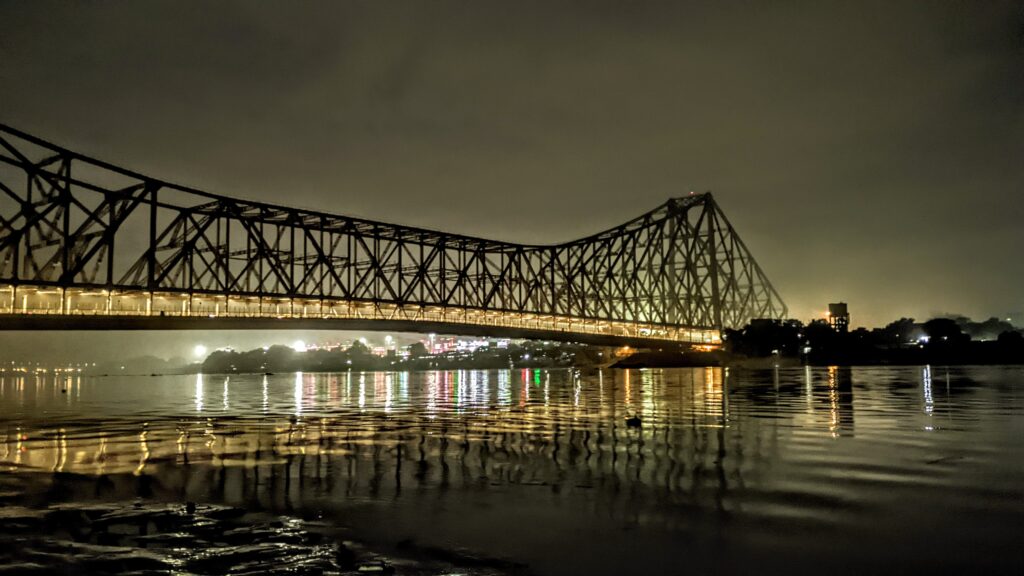“Kolkata doesn’t just feed you—it tells you a story in every bite.”
Walk down almost any lane in Kolkata and you’ll notice it—the city seems to run on two things: conversation and food. Even in 2025, with food delivery apps buzzing in everyone’s pockets, the pull of a steaming plate handed over a cart counter remains irresistible. Post-pandemic, people seem more willing to eat in the open air, chatting with strangers while balancing a paper plate in one hand. And street foods in Kolkata leaned right into that mood, blending old-school flavors with the occasional experimental twist (paneer butter masala momo, anyone?).
These are the five street foods I’d bet my last ten-rupee coin on if you want to taste the city at its most alive.
1. Kathi Roll – Kolkata’s Portable Street Food Legacy
The story goes that in the 1930s, busy office workers in New Market didn’t have the patience to sit down for kebabs. Nizam’s—a small eatery back then—wrapped skewered meat in a flaky paratha, and the Kathi Roll was born. Decades later, the formula hasn’t really changed, though fillings now range from smoky chicken tikka to paneer laced with green chutney.
Where I’d go:
- Nizam’s, New Market – for that old-school mutton roll with just the right chew.
- Hot Kathi Rolls, Park Street – slightly pricier, but the smoky aftertaste stays with you.
What it’s like:
- Base: Crisp-edged paratha or paper-thin roomali roti
- Filling: Spiced kebabs, onions, squeeze of lime
- Overall impression: Cozy, untidy, and unrepentantly fulfilling
Excellent if you want a meal that moves as quickly as you do.
2. Phuchka – Tang and Theater in a Single Bite
Yes, the rest of India calls it pani puri, but Kolkata’s phuchka is its own creature—more spice in the mashed potato filling, sharper tang in the tamarind water. Watching a vendor’s hands move—punching holes, stuffing, dunking, serving—is half the fun.
If you’re asking locals where to start:
- Vivekananda Park – where the water can make your eyes water (in a good way).
- Gariahat Market’s evening crowd – a different vibe, but equally addictive.
Local tip: Whisper “aamer achar” if you see mango pickle jars on the cart; you’ll get a rare, tangy-sweet seasonal variant.
Best eaten standing up, napkin in one hand, your dignity in the other.
3. Telebhaja – Rain’s Favorite Street Food Snack
If the kolkata monsoon had a snack soulmate, it’d be telebhaja—deep-fried fritters that can be made from almost anything: brinjal slices, spiced potato, even pumpkin flowers. Locals don’t really “order” telebhaja; they point at the pile and hope it’s still hot.
Where the magic happens:
- Kalika Mukhorochok Telebhaja, College Street – the queue says it all.
- Small stalls near Shobhabazar – fewer tourists, more neighborhood charm.
On the plate:
- Beguni (eggplant fritters)
- Aloor chop (potato patties)
- Mochar chop (banana blossom fritters)
Crisp on the outside, comfort on the inside—best with muri (puffed rice) and a drizzle of mustard oil.
4. Mughlai Paratha – Heavy, But Worth the Nap
Mughlai Paratha is a hybrid of a fried pancake and packed bread that doesn’t try to be light. Packed with eggs, minced beef, and spices, it is fried until golden and served with cucumber salad and spicy chutney on the side.
For the classic experience:
- Anadi Cabin, Esplanade – the kind of place where the menu hasn’t changed in decades.
- Dacres Lane stalls – cheaper, slightly oilier, but beloved by office workers.
Why I like it: It feels like a proper sit-down meal, except you’re standing in a lane dodging scooters.
One of those dishes you promise to “just try” and then suddenly you’re scraping the plate.
5. Mishti Doi – Sweet, Slow, and Soul-Soothing
Street food in Kolkata doesn’t always have to be fried or spicy. Mishti doi—a caramel-tinted sweet yogurt—proves that. Served in little earthen pots that somehow make it taste better, it’s slow-fermented until thick and custardy. Some vendors chill it with a block of ice under the counter, a welcome relief after a day of masala-heavy snacking.
Go-to spots:
- Balaram Mullick & Radharaman Mullick, Bhawanipur – where tradition is non-negotiable.
- Mithai, Ballygunge – slightly modernized, but still worth it.
Like ending a loud conversation with a quiet, knowing smile.
What You Should Know Before You try Street Foods in Kolkata
- Cleanliness matters: Busy stalls mean fresher turnover. If you see flies or stale oil, skip.
- Spice check: “Kom jhaal” will save you if you’re not a spice veteran.
- Cash is king: Small bills make life easier.
- Time it right: Evening hours (5–9 pm) have the most variety and energy.
Eating Like a Local – A Few Tips
- The best time to explore street food in the city is right after dusk, when things move a little more slowly.
- You should follow the crowd if locals are waiting in line.
- Vegetarian options include mishti doi, beguni telebhaja, and paneer rolls.
- Be aware that dairy, gluten, and mustard oil are frequent allergies; inquire if you’re unsure.
Street food in Kolkata is more than just the meal; it’s also the conversation with the vendor, the rain that could ruin your paper plate, and the mutual nods between strangers at the same phuchka stand. If you’re lucky, you might be able to pull up a chair—or at least a street corner—in 2025, when the city still feels like it’s dining together.

